Let us imagine a city in great economic and cultural ferment, such as Genoa was in the mid-sixteenth century. Let us imagine an aristocracy that based its wealth on maritime trade with all the then known world. Let us imagine that this aristocracy wanted to create a new residential district that could accommodate sumptuous palaces, through which they could then host representatives of foreign powers: the Republic, in fact, lacked representative offices, and foreign ambassadors and sovereigns, starting officially in 1576, were hosted in the most sumptuous city residences, listed in a series of lists known as the Rolli (a word we might translate somewhat as “roles,” “lists”). Imagine, finally, a wealthy member of this patriciate, Tobia Pallavicino, who by trade traded inalum (a mineral that was used in textiles) and who in 1558 decided to have his palace built at the beginning of Strada Nuova, the magnificent street, opened eight years earlier, that formed the centerpiece of the wealthy residential district mentioned above. Here it is: once we have finished imagining we will have pictured for ourselves a splendid building, an expression of the owner’s desire to live in a building updated on the most modern taste, and to compete in magnificence with the other residences of the Strada Nuova. This building, if we go to Strada Nuova, will be the second one we will find: it is Palazzo Tobia Pallavicino, also known as Palazzo Carrega-Cataldi from the name of the two families who owned it between the 18th and 19th centuries, and today the headquarters of the Genoa Chamber of Commerce.
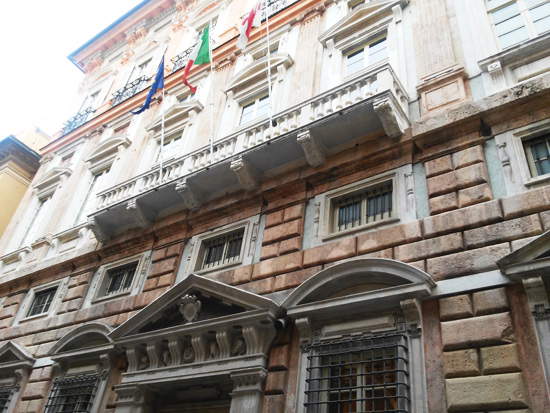 |
| The facade of Palazzo Tobia Pallavicino |
But let us return to the mid-sixteenth century. Tobia Pallavicino had commissioned for the project a learned and versatile artist, Giovanni Battista Castello (Crema, 1525/1526 - Madrid, 1569), known as Il Bergamasco because of his provenance, and so as not to confuse him with a miniaturist of the same name who lived in the same years (and who was known, in contrast, as “il Genovese”). Bergamasco was not only responsible for the architectural structure, as he was the architect, but also for the decorations: he was, in fact, a talented painter trained in Raphaelesque culture. According to what the sources tell us, Bergamasco had first studied in Crema under Aurelio Busso, and then went to Rome to update his figurative culture on the example of the art of the great Raphael. Aurelio Busso is attested to have been a pupil of Polidoro da Caravaggio, a painter who, in turn, was a pupil of Raphael: the Bergamasco could therefore not have looked to other examples. Incidentally, tradition has it that the stay in Rome was sponsored precisely by Tobia Pallavicino, who is said to have known Giovanni Battista Castello, when he was still a boy, precisely in Genoa, where he would still have arrived together with his master. However, according to the account (who knows how true) of Raffaele Soprani in his Lives, Aurelio Busso would have “left him in neglect.” The young artist, “not losing heart,” would nevertheless have continued his activity as a painter, only to be noticed, as was said, by Pallavicino himself, who would have decided to send him to Rome “fin’a tanto ch’ei s’acquistò nome di ben fondato disegnatore.”
And already in the atrium of the sumptuous Palazzo Tobia Pallavicino we are able to perceive how much Roman culture the Bergamasque had imported to that of Genoa. The vault of this scenographic room, concluded by a double staircase (whose left ramp, moreover, leads to a fake door, placed there only for reasons of symmetry: when they say aesthetics before functionality... !), is in fact decorated with grotesques: these are motifs with geometric, plant, animal and fantastic elements that are woven into ornamental fabrics on a usually white background, offering the viewer effects of lightness, airiness and harmony. To understand the origin of the term “grotesques,” we need to go back to the last years of the fifteenth century, when the remains of the Domus Aurea, the palace of Emperor Nero, were discovered: since it was necessary to go underground to visit it, people of the time had begun to refer to this environment as the “Roman grottoes.” And the walls of these “grottoes” were filled with ornamental motifs such as those we mentioned above: artists were thrilled by the discovery, and from the end of the fifteenth century grotesques began to appear in the decorations of a great many palaces. With Bergamasco, grotesques were arriving for the first time in Genoa. And they could not have debuted in a more suitable setting: in fact, the iconographic program wanted the atrium decorated with images of the Olympian gods. So here are Apollo, Diana, Juno, Leda, Jupiter, Saturn... and there is also a very refined Argo, the giant with a hundred eyes, who in Bergamasco’s frescoes takes on the features of a comely young man with eyes scattered all over his body, which from below look almost like small tattoos covering a good part of his skin. Somewhat like he was depicted on ancient Greek vases, in short.
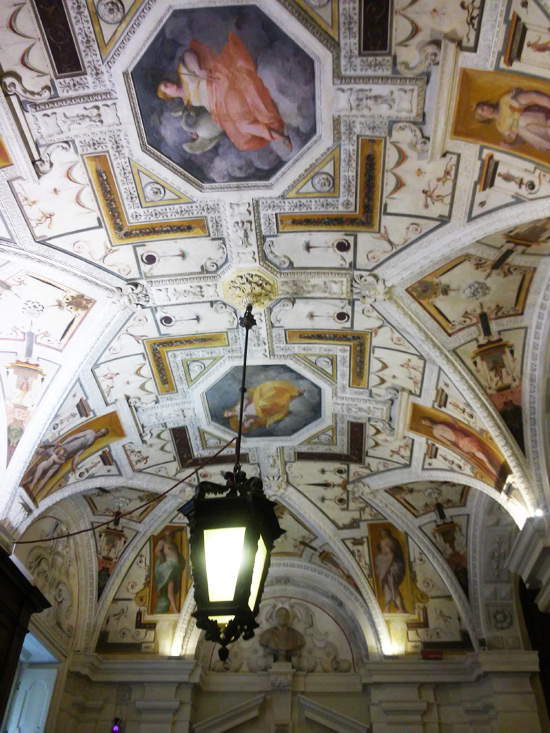 |
| Giovanni Battista Castello called the Bergamasco, vault of the atrium of Palazzo Tobia Pallavicino (1558-1561; frescoes and stuccoes; Genoa, Palazzo Tobia Pallavicino) |
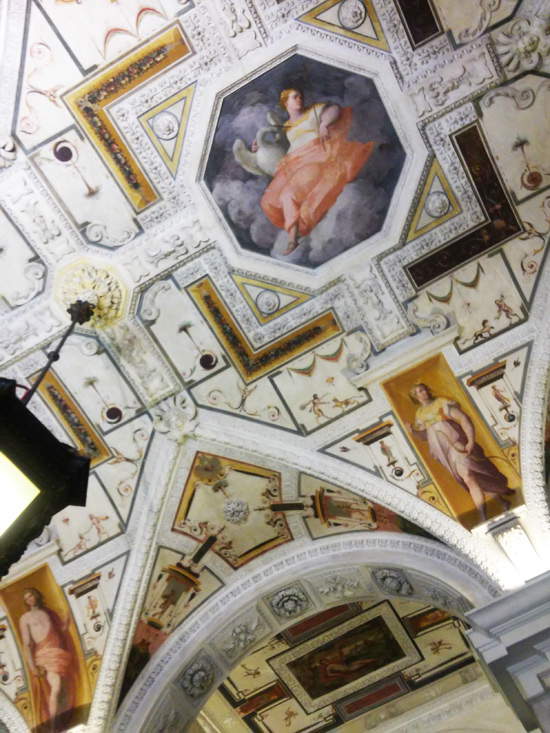 |
| In the medallion Leda, and in the corbels of the arch Apollo and Diana |
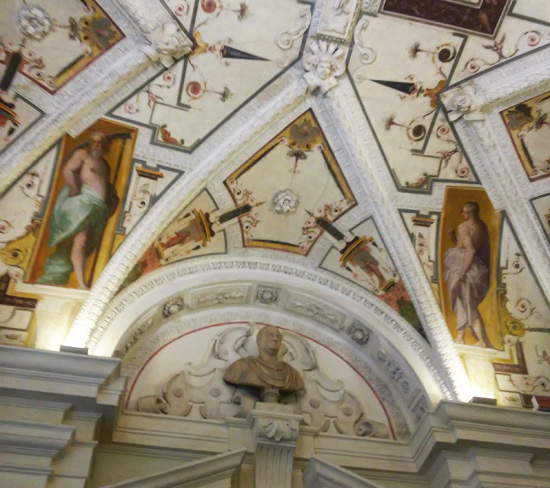 |
| Saturn and Argo |
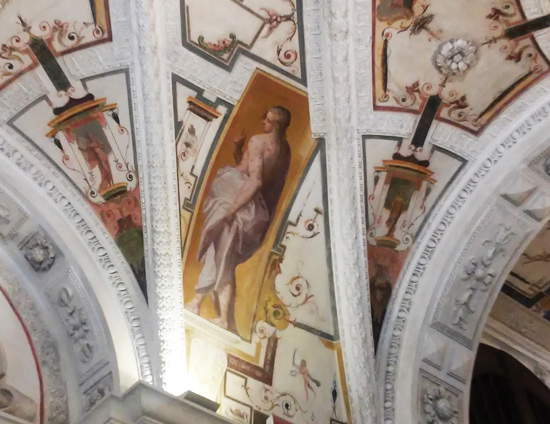 |
| Argo |
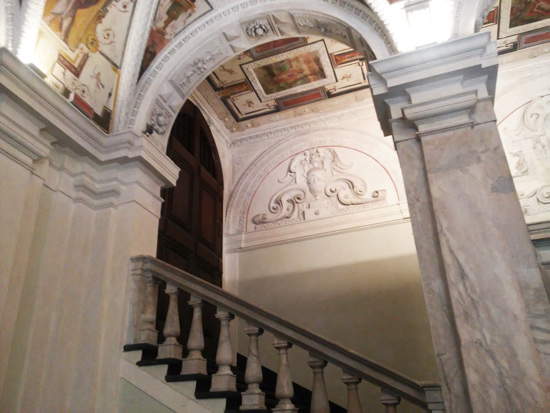 |
| The staircase leading to the... false door |
In the space leading to the great hall on the first floor, depictions of the four natural elements were to appear: water, air, earth, and fire. However, there was only room for three elements. And in connection with this, an anecdote is told: when Tobia Pallavicino asked Giovan Battista Castello where the fourth element ended up (the only ones he had been able to depict in the panels were water, earth, and fire), the artist is said to have responded by stating that air was represented by the clouds on which Juno and Leda sit in the large octagonal medallions that decorate the atrium vault. Faced with such a witty answer, it is easy to imagine how the noble patron would have had no quarrel.... !
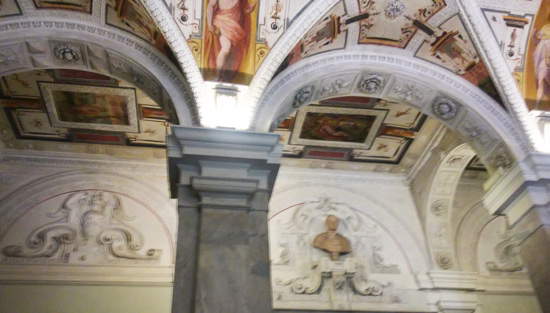 |
| The compartment with the allegories of the elements |
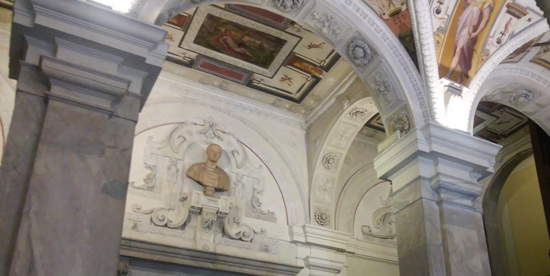 |
| Allegory of water |
Continuing on, one enters the salon: here, the large fresco in the vault depicts Parnassus, the Greek mountain where, according to mythology, the god Apollo met with the nine Muses, the patron deities of the arts. Apollo is in the center, holding the zither, his typical iconographic musical instrument. The Muses are around him: dancing, playing, or engaging in poetry. The winged horse that appears immediately below Apollo is Pegasus: legend has it that this mythical animal, with a blow of its hoof, opened a spring, later called Hippocrates, which would give, to those who drank it, poetic inspiration. The large fresco is immersed in a structure decorated with stucco and adorned, on the sides, with large panels housing allegories of the arts. The grace that pervades the composition harks back to the more famous example of the Parnassus frescoed by Raphael in the Stanza della Segnatura: the Bergamasque, having been to Rome, must surely have known it. Just as he will certainly have known the Loggia di Psyche: the airiness of the Lombard-ligurian artist’s paintings seems to echo that of Raphael’s Farnesina, and given the friendly relations Tobia Pallavicino had with the wealthy banker Agostino Chigi, owner of the Villa Farnesina, the hypothesis that it was the Genoese patrician himself who suggested the artist visit it does not seem so unlikely.
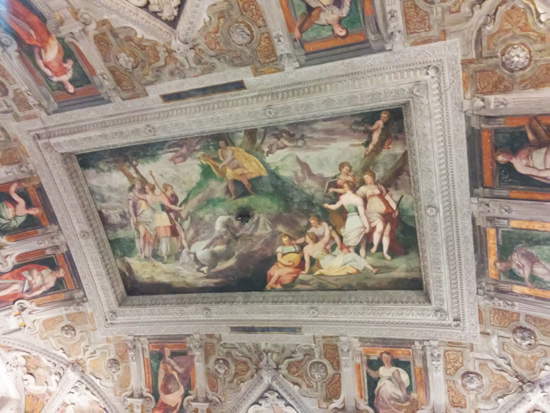 |
| Giovanni Battista Castello called the Bergamasco, The Parnassus (1558-1561; frescoes and stuccoes; Genoa, Palazzo Tobia Pallavicino) |
 |
| The vault of the Salone |
Ascending to the upperfloor, we enter theatrium of the piano nobile: the ceiling is decorated, in the center, with a fresco in which we find the figure of Apollo citaredo, or zither player, accompanied by three muses, while in the six side medallions we find musician figures. The almost ubiquitous figure of Apollo, as we can guess, refers back to Tobia Pallavicino himself: the iconographic program he had in mind was strongly celebratory, and he mixed elements that let us denote how refined his mythological culture was, with others that instead have the clear function of exalting the qualities of the patron. Apollo is a god who, through his art, grants harmony and happiness to humans: the same was intended by Tobia Pallavicino through his commercial activities. Apollo is a god who protects artists, and the same role was assumed by the patron. But Apollo was also a god who punished those who dared to challenge him: a fresco appears in the vestibule on the piano nobile in which Apollo shoots down the monstrous Python, who had made the grave mistake of persecuting the god’s mother. Was Tobia Pallavicino, too, therefore, not very tolerant of his opponents?
 |
| The vault of the atrium of the piano nobile |
In the last drawing room, adjoining the atrium and now set up as an office, Bergamasco created several frescoes that narrate the salient episodes of the tale of Cupid and Psyche, taken from Apuleius’ Metamorphoses. The salient moment of the tale, the one in which Psyche discovers who her lover is by catching him in his sleep, is placed in the center of the ceiling: a marvelous Psyche, blond and half-naked (covering her is only a veil that encircles her hips) is pulling the covers off the bed while Cupid lies still asleep, his head resting on one arm. Accompanying the gaze toward the two figures is the scenic canopy whose curtains open, like a curtain, as if we were watching a play. Emilian suggestions in the gentle chiaroscuro passages, and Venetian in the rather bright colorism of this and all the other episodes of the fable that decorate the side walls, mingle on Raphaelesque substrate to explore new solutions, destined, moreover, to set the school in mid-sixteenth-century Genoa: remember that we are between 1558 and 1561.
 |
| Giovanni Battista Castello called the Bergamasco, Amore e Psiche (1558-1561; fresco; Genoa, Palazzo Tobia Pallavicino) |
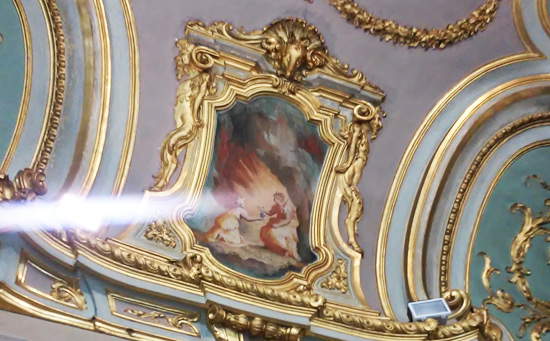 |
| Psyche brings the jar to Venus |
Giovanni Battista Castello had, in essence, brought great innovation to Genoa. If we had to find a particularly representative artist of Genoa of the time (excluding the unmatched and brilliant Luca Cambiaso, of course), we would have no great difficulty in naming the Bergamasco: together with Cambiaso and Andrea Semino he is the greatest exponent of Genoese painting of the time, a painting destined to set the standard. And a painting, that of the artist originally from Lombardy, destined to be repeated in other endeavors for Tobia Pallavicino. Then, with the centuries, the luxurious palace on Strada Nuova would pass, as mentioned in the opening, to other owners, enriching itself with new splendid decorative apparatuses: but we will tell you about that next time!
Reference bibliography
The author of this article: Federico Giannini e Ilaria Baratta
Gli articoli firmati Finestre sull'Arte sono scritti a quattro mani da Federico Giannini e Ilaria Baratta. Insieme abbiamo fondato Finestre sull'Arte nel 2009. Clicca qui per scoprire chi siamoWarning: the translation into English of the original Italian article was created using automatic tools. We undertake to review all articles, but we do not guarantee the total absence of inaccuracies in the translation due to the program. You can find the original by clicking on the ITA button. If you find any mistake,please contact us.